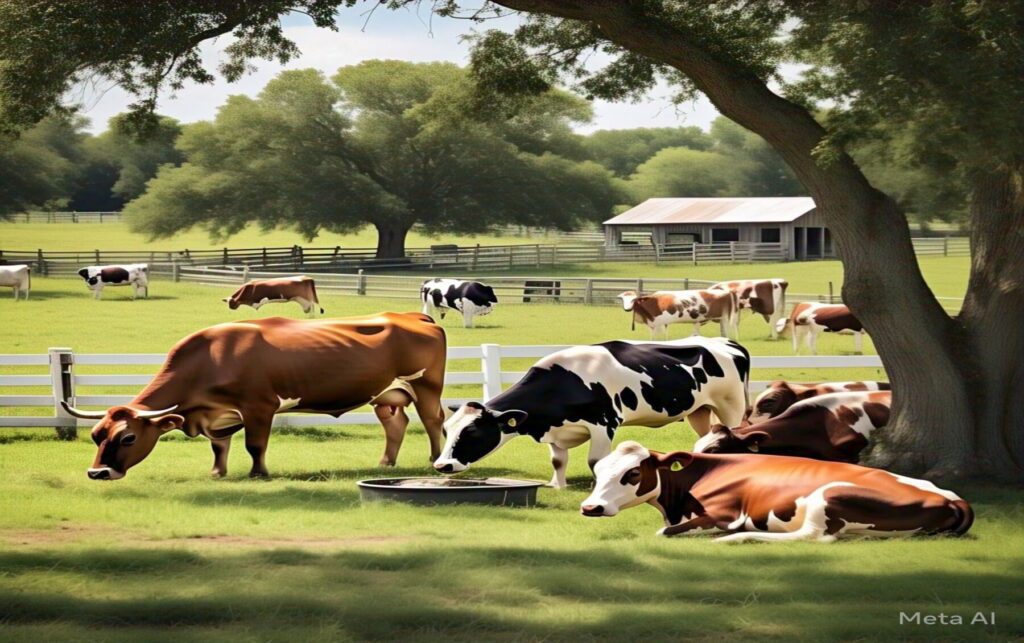Cow and Cattles Different Breeds
Cattle, commonly known as cows, are among the most significant domesticated animals worldwide. Cattle play a crucial role in agriculture, providing milk, meat, and labor. Over centuries, various breeds have been developed to adapt to specific climates, terrains, and human needs. There are around 250 different types of cattle. This article explores different types of cows across various regions, their unique characteristics, and addresses common questions related to cattle breeds.
Different Type of Cattle
As it is already mentioned that there are more then 250 differete types of cows in the world. Here are the different type of cattle with there feature.
Angus Cow
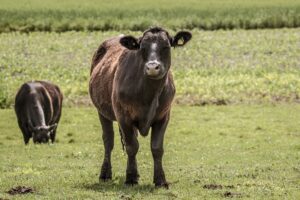
Black Angus cattle, also known as Aberdeen Angus, are the most popular breed in the U.S. Their meat is highly valued due to strong marketing, and cattle with mostly black markings often sell for higher prices. This breed originally comes from northeastern Scotland and was brought to the U.S. in 1873 by a Kansas rancher. When crossed with Texas Longhorns, the black calves added winter hardiness. Angus cattle are naturally hornless, with black skin and hair. They are medium-sized, good mothers, and known for growing quickly, producing good milk, and having excellent marbled meat.
Jersey cow
The Jersey, a small British dairy cattle breed from the Channel Island of Jersey, is renowned for its high-butterfat milk, which has a distinctive yellowish hue. One of three Channel Island breeds—alongside the extinct Alderney and the Guernsey—the Jersey adapts well to diverse climates, including heat, and has been exported worldwide, developing into independent breeds in countries like Denmark, France, New Zealand, and the United States.
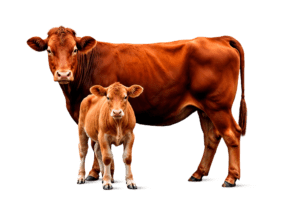
Originating from Norman cattle stock and first recorded as a distinct breed around 1700, Jerseys were isolated for over 200 years due to an import ban (1789–2008) to preserve their purity. Known for their small size (350–400 kg for cows, 600–700 kg for bulls), Jerseys are economical to raise due to lower maintenance needs, superior grazing ability, high fertility, and ease of calving. Jersey cow horn are small and curved with black color at the tip. Both bull and cow of Jersey breed have horn.
Jersey cow milk is rich in butterfat (4.84%) and protein (3.95%), containing 20% more calcium, 18% more protein, and 29% more milk fat than Holstein milk. Jerseys come in various shades of brown, often fawn, with distinctive lighter muzzles, dark tail switches, and black hooves. While cows are docile, bulls can be unpredictable. Despite their advantages, Jerseys are prone to milk fever and require attentive calf management in cold weather. The breed’s popularity stems from its efficiency, high-quality milk, and versatility, making it a valuable asset in both dairy and crossbreeding programs worldwide.
Belted Galloway
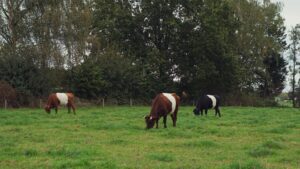
Belted Galloways, often called “Oreo cattle” because of their black (or sometimes brown or red) color with a white stripe in the middle, originated in Scotland. They got their distinctive look by mixing with Dutch Belted cattle. First brought to the U.S. in 1950, these cows are often chosen for their unique appearance but also produce lean, high-quality beef. They are medium-sized, and their carcasses can weigh more than 60% of their live weight. Belted Galloways have a thick double coat, which keeps them warm in winter without needing extra backfat like other breeds.
Brahman Cow
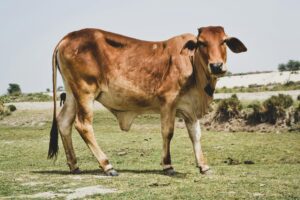
Brahman cattle, originally from India, are one of the most adaptable and widely recognized breeds. Developed in the U.S. in the late 19th century using Gir, Guzerá, and Nelore cattle, they were officially recognized in 1924. Today, they are found in over 55 countries, with a global population exceeding 1.8 million. Especially popular in Australia, they thrive in hot, humid climates due to their loose skin, large ears, and a prominent hump that helps regulate body temperature. Their ability to sweat more than other breeds and secrete an insect-repelling oil makes them highly resistant to heat, pests, and diseases. They are also known for their ability to survive on poor-quality forage.
Brahman cattle are widely used in crossbreeding to improve hardiness in other breeds. They have contributed to hybrids like Brangus (Brahman x Angus) and Simbrah (Brahman x Simmental), combining their durability with superior meat quality. Though their beef is leaner than European breeds, it is valuable in hot regions. Beyond meat production, Brahman bulls are used in bull-butting competitions in Oman and Fujairah, where they are fed special diets to enhance strength. Their resilience, adaptability, and strong genetics make them a key breed in the global cattle industry.
Charolais Cow
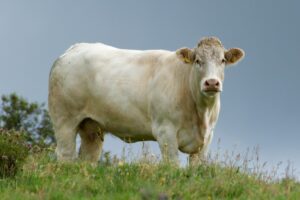
Charolais cattle, originally from the Charolais region of France, are known for their large size, strong build, and high-quality beef. They are the most common beef breed in France and have been exported to many countries, with a global population of around 730,000. The breed was first introduced to the U.S. through Mexico in 1934, but due to a disease outbreak, further imports were banned until 1965. As a result, many American Charolais today have mixed ancestry. These cattle adapt well to different climates, graze actively in warm weather, tolerate cold, and produce large, muscular calves.
Charolais are commonly used in crossbreeding to improve beef quality and carcass size. They have been crossed with breeds like Angus and Hereford, and hybrids such as Charbray (Charolais x Brahman) and Char-Swiss (Charolais x Brown Swiss) have developed. Bulls can weigh between 2,200 and 3,600 pounds, while cows range from 1,500 to 2,600 pounds. Their coat varies from white to cream, with a distinctive pink nose. Using a Charolais bull in a herd can significantly increase the size, strength, and meat yield of the calves, making them a valuable breed in beef production worldwide.
Dexter Cow
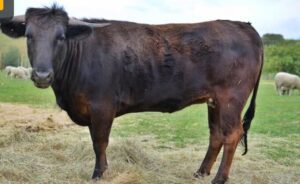
Dexter cattle, originally from southern Ireland, arrived in the U.S. in the early 1900s. They are one of the smallest cattle breeds, with bulls standing 38 to 44 inches tall and weighing under 1,000 pounds. Some Dexters have long legs, while others are shorter. Their small size means they need less pasture and feed than larger breeds. They adapt well to both hot and cold climates and are known for their gentle nature. Dexters are highly fertile, easy to calve, and can be raised for both milk and meat. They produce more milk for their weight than any other breed, with up to a quart of cream per gallon. Their beef is lean, darker red, and consists of small, high-quality cuts.
Brown Swiss
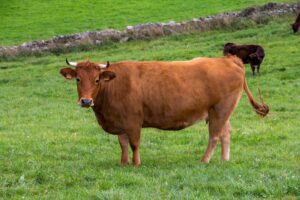
The American Brown Swiss, often just called Brown Swiss, is a breed of dairy cattle that originated from the Braunvieh cattle of the Alpine region in Europe, particularly Switzerland. Initially, Braunvieh was a triple-purpose breed used for milk, meat, and draft work. However, when the breed was imported to the U.S. in 1869, its focus shifted to dairy production, and over time, its beef and draft capabilities were lost. By the early 1900s, the breed was being selectively bred for high milk yield, and the Brown Swiss became recognized for its ability to produce a large volume of milk with about 4% butterfat and 3.5% protein, which makes it ideal for cheese production. In fact, Brown Swiss milk is unique because it has longer-chain fatty acids and smaller fat globules compared to other dairy breeds, which affects how the cream rises and makes it especially well-suited for cheese production.
This breed has spread globally, with an estimated population of seven million worldwide by 1990. It’s also often used in crossbreeding programs with other dairy breeds to improve milk yield. However, the breed has faced challenges due to intensive breeding practices, which have led to a reduction in genetic diversity and an increase in certain genetic defects, like “weaver disease” and spinal muscular atrophy. Physically, the American Brown Swiss is of medium size, with a coat that ranges from light grayish brown to almost white or darker shades. Its muzzle is distinct, being black with a creamy white ring. This breed is widely appreciated for its milk production and is found in many countries, contributing to the development of modern dairy breeds.
Gelbvieh cow
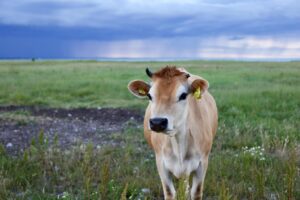
The Gelbvieh breed originated in Bavaria, southern Germany, where it was developed for meat, milk, and draft work. Introduced to the U.S. in 1971 through an artificial insemination program, Gelbvieh cattle are now highly valued for their high fertility, ease of calving, strong maternal instincts, and rapid calf growth. Purebred females are registered at 7/8 Gelbvieh, while bulls require a 15/16 lineage, and in Germany, bulls must pass rigorous testing to qualify as A.I. sires. Known for their distinctive red coat and pigmented skin, Gelbviehs were originally horned, but many today are naturally polled due to crossbreeding with polled foundation females in the U.S. These traits make Gelbvieh cattle a productive and efficient choice for modern ranchers.
Hereford
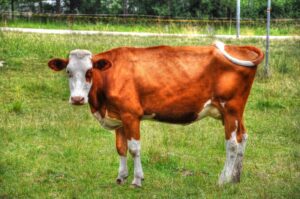
The Hereford breed originated in England in the 1700s to meet the growing food demand during the Industrial Revolution, prized for their high beef yield and efficient production—traits that remain central to the breed today. Introduced to the U.S. in 1817, Herefords played a key role in improving herds in the Southwest, gaining popularity due to their early maturity and ability to fatten efficiently. As consumer preferences shifted in the 1950s, Herefords were selectively bred to be leaner, with less fat and more red meat. Today, both horned and polled Herefords are widely found in the U.S., valued for their longevity, docile temperament, ease of calving, strong maternal instincts, and excellent milking ability, making them a versatile and enduring choice for cattle producers.
Holstein Friesian
Holsteins, best known as dairy cows, originated in Holland over 2,000 years ago, First brought to America in the 1850s to meet rising milk demand, they were later introduced to Kenya in the early 1900s. Renowned for their exceptional milk production, Holsteins are also raised for beef when not used for breeding or dairy purposes. These large cattle weigh around 1,500 pounds at maturity, with healthy calves typically weighing 90 pounds or more at birth. Interestingly, no two Holsteins have the same spot pattern, making each one unique. With a productive lifespan of about six years, their dual-purpose utility—combining high milk output and beef potential—makes Holsteins an indispensable breed in both the dairy and beef industries.
Limousin
Limousin cattle, with origins potentially dating back 20,000 years, are depicted in ancient cave paintings in France that strikingly resemble the breed today. Native to France, these golden-red cattle were originally used as draft animals to cultivate rugged, rocky terrain into farmland. The breed wasn’t introduced to the U.S. until 1971, arriving via Canada, and has since grown to over a million registered head. In 2002, the Lim-Flex, a pedigreed hybrid of Limousin and Angus, was officially recognized, combining the best traits of both breeds for modern cattle production.
Piedmontese
The Piedmontese breed, with a history spanning 25,000 years, is a unique genetic blend of the European Auroch and Pakistani Zebu. Brought to North America in 1979, these cattle are known for their exceptional muscularity, disease resistance, and hardiness compared to other beef breeds. A genetic mutation allows them to develop muscle at an unrestricted rate, resulting in 14% higher muscle mass and earning them the classification of “double-muscled” cattle. Beyond their beef qualities, Piedmontese milk is a key ingredient in several traditional Italian cheeses, making this breed versatile and highly valued in both meat and dairy production.
Red Angus
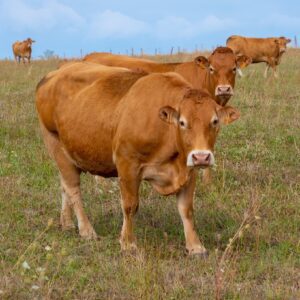
The Highland breed, one of the oldest registered cattle breeds, thrived for centuries in the harsh, rugged Scottish Highlands, developing a natural resistance to stress-related and other bovine diseases. Adapted to cold climates, Highlands rely on their long, insulating hair rather than a fat layer for warmth, resulting in lean beef with minimal waste fat. Remarkably versatile, they also excel in southern climates and can thrive on brush and weeds that other cattle avoid. Known for their distinctive long horns, protective eyelashes, and forelocks that shield against insects, Highlands are prized for their even temperament, intelligence, and ability to flourish in diverse environments.
Scottish Highland
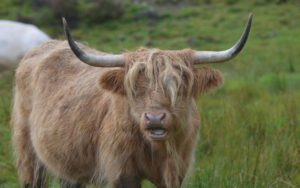
The Highland breed, one of the oldest registered cattle breeds, evolved over centuries in the rugged Scottish Highlands, where it developed remarkable resistance to stress-related and other bovine diseases. Known for their adaptability, Highlands withstand cold weather and snow thanks to their long, insulating hair, which replaces the need for a thick fat layer, resulting in lean, high-quality beef with minimal waste fat. Surprisingly, they also thrive in southern climates and can graze on brush and weeds that other cattle avoid. With their iconic long horns, protective eyelashes, and forelocks that shield against insects, Highlands are celebrated for their even temperament, intelligence, and ability to flourish in diverse environments.
Shorthorn Cow
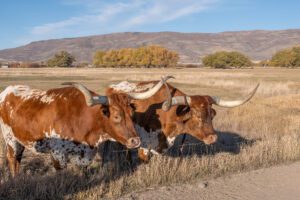
Shorthorns originated on the northeast coast of England and were introduced to America in 1783, where they were initially known as Durham cattle. Highly valued by settlers for their versatility, they were used for meat, milk, and as draft animals to pull wagons and plows. Shorthorns can be either horned or naturally polled, with polled Shorthorns becoming the first major beef breed developed in the U.S. in the 1880s. Renowned for their adaptability, strong maternal instincts, reproductive efficiency, calm disposition, longevity, and excellent feed conversion, Shorthorns remain a popular and reliable choice for both beef and dairy production.
Simmental
The Simmental breed, one of the oldest and most globally widespread cattle breeds, has been raised in the U.S. since the late 1800s, though its popularity declined until a resurgence in the late 1960s. Typically red and white but with no strict color restrictions, Simmentals are prized for their rapid growth, high milk production, and large size. While primarily used as dairy cattle in Europe, American Simmentals are predominantly bred for beef production, combining versatility, efficiency, and robust performance to meet the needs of modern cattle producers.
Texas Longhorn
The Longhorn, a truly American breed, was shaped by natural selection and adaptation over 500 years, tracing back to the first cattle brought to North America. However, by 1900, the breed nearly vanished due to crossbreeding aimed at producing faster-maturing cattle. Rescued from the brink of extinction, Longhorns have regained popularity for their hardiness, adaptability, and exceptional traits, including high fertility, ease of calving, resistance to disease and parasites, and remarkable longevity. Known for their ability to thrive on coarse forage that other breeds avoid, Longhorns are a resilient and efficient choice for modern cattle operations.
Ankole Watusi
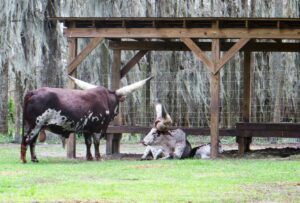
The Ankole-Watusi, also known as African Ankole-Watusi, boasts a lineage dating back over 6,000 years to long-horned cattle in the Nile Valley, even depicted in ancient Egyptian pyramid art. Later revered by Tutsi kings and chiefs, this breed is famous for its massive horns, which can span up to 8 feet, making them a popular attraction in European zoos. Medium-sized with small calves, Watusi bulls are ideal for breeding with first-calf heifers or smaller breeds. Known for their ability to withstand extreme weather, they thrive in hot climates, aided by their large horns that help regulate body temperature by circulating and cooling blood. Additionally, Watusi cattle produce lean, low-fat, and low-cholesterol beef, making them a unique and valuable breed.

